Mind Streaming
John Coxon's Online Journal|
Archive Search |
| Links |
|
and s-integrator |
Friday, May 30, 2003
NEWSPAPER STORY
Returning from photographing the neglected nearby local, disused parish church yard , we came upon a police officer directing traffic to my left, down Station Road and to my right, towards Clifton ; the Main Bolton Road was obstructed immediately in front of us by a police Volvo Estate car at right angles across the carriageway, cordoning off the stretch of road in front of us. A huge articulated lorry was stationary, half way across the normally very busy crossroads, pointing towards us, with a row of cones in front of it. An open ambulance was next to it : paramedics were evidently giving first aid to some unfortunate near the huge rear wheels of the lorry.
Although mindful of a sort of unspoken ethic when it comes to taking pictures of certain things, I took a shot as a rare opportunity to illustrate the professional way the Police and our Emergency Services manage such incidents. Two minutes later, following the police diversion, we were back on the same road and parked close by the shop we wanted to visit. The ambulance had , by now, gone ; the Police were clearing up and getting ready to restore the traffic flow. I took three more shots from some distance back. Click on this thumbnail to see a larger photo taken from a differnt angle. 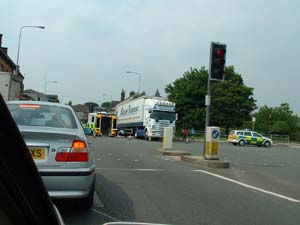
A bystander said an elderly lady, trying to cross the busy main road, had stepped in front of the lorry without looking.The front wheels had run over her legs. The lorry braked hard and narrowly missed running over her a second time with the four rear wheels. The litter of her shopping suggests , poignantly, where she was trying to cross. While I watched, I was amazed at the diplomacy another police officer was having to show with some extremely rude and impatient motorists resentful of having to wait or being diverted.
From time to time I feed items of local interest , successfully, to the local Salford Advertiser newspaper, and I phoned them about this accident and also to report on the Civic Town Twinning reception I'd attended earlier that day. It is a free paper but excellent, funded by its advertisements and with a small staff of journalists, they welcome frelancers they know are reliable. I sent an immediate e mail with thumbnail attachments of some of the pictures. The journalist at the newsdesk, I then spoke to, wanted high resolution images and these I had to send as jpeg attachments one at a ponderous time. (I knew that, in production processing, there is a marked deterioration in image resolution and papers and magaines, thus demand the highest resolution you can muster.
At present, while fees are offered for this, I am content just to have a simple acknowledgement with any photos they use. Th Advertiser is part of the large Guardian Media group and maintains amongst other publictions, all the local regional free newspapers. There is quite a large turnover of journalist staff at the Advertiser. Writing copy is good practice, but offering it the way I do now enbles me to 'network'; later on I will happily be charging as I get better at this style of writing and I have developed a proven track record.
johncoxon 10:39 AM - [Link] - Comments ()
...
UK CULTURE / RELIGION
Thursday, May 29, 2003
CHURCHES,GRAVEYARDS AND HEADSTONES
The Church of England may well still be, along with the railways, the biggest landowner in the Britain. England was organised in parishes in former times, each little area had its parish church and normally, within a parish, a person was christened in the parish church, married there, and indeed was buried there. Early parish records are an invaluable resource for those researching their family history. Here is a little gem of an historical pointer that I pictured a few yards from our home, so easily missed by passers by. It denotes one of these ancient parish boundaries.
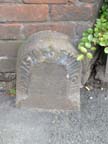
Alas, whilst Britain has so many architecturally varied and beautiful little ancient local churches, some as old as Saxon times, and before, many are in a sorry state. Congregations diminished particularly at the end of the twentieth century and alas some of those churches became disused, fell into disrepair and some were even demolished. Those that survive are constantly appealing for help in maintaining the fabric of the buildings.
Near our home is a local Pendlebury parish church, which has long since ceased to hold services. On the street there is no longer even a placard announcing its name. Curiously there are a few modern, fairly fresh graves to the south of its grounds, but everywhere is a feel of neglect. Within its grounds, still, on the western side is an overgrown graveyard, with headstones all facing due south.
The majority of the well-preserved head stones are still upright (obscenely, we now have a problem of vandalism to consecrated ground with headstones pushed over and defaced in some quarters of our city) and announce, in beautiful hand-carved Victorian monumental mason's script, the names and dates of local people from the 1880's to the turn of the century in particular interred beneath. They are not, in the modern tradition of preferred expensive, imported, shiny, durable igneous black granites or softer marbles (the latter vulnerable to corrosion/erosion from the acidic rain in our polluted atmosphere)

Because of pressure land, the practice of internment has become increasingly expensive and many elect for cremation; "gardens of remembrance" , where vessels containing human ashes are buried take up less space, and are increasingly common. Where, for example there is a family grave, the custom is for that plot to be re-opened to accept the remains of other family members and their names to be added to the existing headstone.
The city of Salford has one main, large cemetery at Agecroft, similar;y names as a former a local coal mine. Graves here date from early Victorian times to the present day and include so called pauper's graves, where once people deceased , too poor ( hence pauper) to pay for a funeral and headstone, were buried by the municipality in pits and shared a headstone with others in mass graves.
Because it is the municipal cemetery it is well maintained, but many local parish church graveyards are, sadly, neglected and overgrown, in part, because the extended family has dispersed. Naturally, those who were buried in those locations at the turn of the century have graves that are no longer maintained, because there are no surviving family members left to look after them.
Because of social mobility, people often no longer have generations from the same family that remain in the same area all their lives. Also, as congregations diminish, there simply are not the funds to keep these small graveyards maintained. This is in stark contrast to, for example, France, where the extended family is still a cultural reality and in the main, no graveyard I have ever visited there , municipal or otherwise, has been allowed to fall into disrepair and they remain remarkably well looked after, and indeed frquently visited.

I was very taken, in that ancient graveyard today with that particular first image and the inscription .In loving memory, it said, in the beautiful hand-chiselled Victorian script, and yet brambles were largely covering it ; nature taking over as it always seems to eventually. "Sic transit Gloria mundi" whispered the past to me when I saw it. I actually have this belief that we can perpetuate the existence of a loved one who has " passed before", "passed away" as the euphemisms go, by keeping them in our hearts and mind, but after a very long time, there is no one to remember them and thus we move on and they fade and only these stones mark their once being alas.
When I "kick the bucket", "pop my clogs" or become, as in the Monty Python sense, "bereft of life" and "have ceased to be", "pining for the fjords" and all that, I'd probably wish to be cremated, and have my ashes scattered at sea, rather than the temporal vanity of wanting a headstone and the liability that represents to my kin having to go and tend a grave , and as they get more frail, feeling anxiety because that task became a burden .
As a sad footnote, I came home from this church visit with a green fragment of Victorian stained glass from this abandoned church retrieved from the overgrown grass.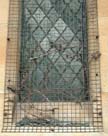
the building no longer functions as a church, it still is preserved, probably as an historic building on one of those official lists. Many of our local churches have amazing stained glass windows, some designed by eminent Pre-Raphaelite artists. And yet this church is one of many random targets for our mindless subculture of teenage philistine deviants and now it is common for all church windows to be grilled from the outside and protected too by Perspex sheeting. Lazy repairers tend to leave the odd fragment of original glass when these windows are damaged and I always look closely for these bits. As regards kids who throw stones at priceless stained glass or push over and desecrate graves, with noting better to do, well, were I a Christian, I'd probably quote that Jesus thing "Forgive them Father, they know not what they do."
U.K.Culture /U.K Heritage/ Blogstudio/Web Log/Mind Streaming/Churches/Religion/
johncoxon 12:26 AM - [Link] - Comments ()
...
UK Veteran Motor Cars : THE ROVER 12 'TOURER'
Tuesday, May 27, 2003

I spotted this remarkably preserved 1947 veteran Rover 12 Tourer parked outside the local History Museum last week and thought I'd take some detailed pictures of it, as it reminded me of many of the predominantly black cars that populated the roads in my early years.
It took me back to a time when people often bought a car from new, but because it was so solidly made, and basic in its engineering and easy to understand tchnology, it was often possible for an owner to do most of the maintenance and repairs themselves and such cars were kept by the original owner far longer that we keep them today . You still saw wartime and post-war vehicles like this on the roads in the fifities. The introduction of the mandatory , triennial Ministry of Transport test of road-worthiness (M.O.T.) had the effect of removing so many older models from our roads for safety reasons. (I'd guess tht most vintage cars are actually salvaged originals in poor shape that have been panstakingly restored by enthuisiasts)
This Rover has the chromed radiator grill, typical of the day, with the radiator water fill on top, and an opening near the bottom which you used to insert a 'crank handle' and 'turn over' the engine, if for example , your battery was dead. 
Rounded, aero-dynamic looking bolt on mudguards on many cars protruded from the main body work, and the large, heavy glass lensed thick chromed headlights were mounted directly onto them. 
Similalryside lights were mudguard mounted and essentially a smaller version of the main head lights.

Another lovely feature of this vehicle and many like it were the rubber matted running boards linking the front and rear mudguards.
From the side view you see that the rear and front doors open with the raised hinge on the left. Between the side windows, mounted in the roof pillar you had a chrome-trimmed indicator by which you indicated the direction the car intended to turn by means of mechanically raising what looked like a little orange arm. Hand signals were still common as well. Instead of, with more modern cars, the bonnet access to the engine in one piece, this Rover has a spilt, hinged engine cowling ; by releasing the chrome bonnet handles, you could easily acess either side of the engine.
The rear of the Rover 12 features a boot where limited luggage space, behind the rear leather upholstered seats was available and , typically for the time, the spare wheel was housed in a recess in the boot lid. Typically too were wire-spoked wheels
Both the radiator grill and the spare wheel cover feature the Rover emblem, which since 1929 has used the familair Viking head and longship ; the proportions of the badge have varied over the years ; emblems on the very latest models nowadays are, of course plastic and I believe simply glued in place. 
A disadvantage of taking phtographs of someone else's vehicle is that it is tricky to photograph though the windows and I didn't feel right putting my camera lens against the glass without the owners consent. However, even with those anniying reflections, you get some idea of the leather upholstered interior, the hand made wood trim and some of the instrumentation.br>
Footnote:-
U.K. DEFINITIONS OF VINTAGE,VETERAN AND CLASSIC CARS
Whilst most of us tend to use the phrases 'vintage car', 'classic car' or 'veteran' cars interchangeably, according to the OLD CLASSIC CARS UK website any vehicle pre-1930 is officially a vintage car, anything from then to WW2 is post-vintage and classic can be a term for vehicles from the 1940s even up to the 1980s in some instances. Veteran and vintage seem to mean the same thing.
The conservative government introduced a road tax exemption for any car over 25 years old, making those vehicles effectively classics, but the present government changed the no tax rule from a rolling 25 years to a fixed date. Thus pre-1973 cars are now 'classics'in one sense of the word, for tax purposes. The web site owner tends to define a classic car as "any vehicle over 15 years old with a fan base."
In the age of Computer generated car design, there is a certain bland monotony on the roads of Britain where rarely does one particular vehicle particularly stand out as being anything other than a variant of so many very similar cars. This perhaps leads many of us to be nostalgic for the more indiviudalistically stylish vehicles from previous generations and for cars like the Rover 12 to still turn heads. Of cours we conveniently forgeten that such vehicles were often very ,uncomfortable, hard to steer, somewhat sluggish and corned like a bucket of wet cement if you took a turn too fast. Distance, as they say, lends beauty to the view.
johncoxon 11:00 AM - [Link] - Comments ()
...
U.K.CULTURE /FOOD/BREAKFAST
"THE DEFINITIVE FULL ENGLISH BREAKAST"
Traditionally here, the condemned prisoner was permitted the luxury of enjoying a final, hearty meal and this would usually, I presume, have been THE Full English Breakfast as tradition demanded morning executions just after sun rise and defintely before brunch, over here at least. It does seem a tad ironic to grant someone, about to have no further use for food, air etc, the luxury of a final meal. Traditionally the rather greasy 'Full English' is not the easiest of meals to keep down when you are hung-over, under the weather, or, for example, coping with the stress of knowing that, as soon as you've cleared your plate, they are going to take you out and hang you.
The traditional British or Full English breakfast in its original , highly calorific, fat-saturated glory ,(when eaten by serious addicts on a long term, regular basis,) is a masochistic form of prolonged suicide. It is a dangerous and endangered species in it original form. 
The traditional English Cooked Breakfast is just one example of something which is, we know, so, ridiculously bad for us, but so wonderful to indulge in, even on a now-and-then basis. It had its origins in providing people who did day-long hard physical work with high levels of fat and carbohydrates to build up energy reserves lost over night , and in the morning, when you'd lterally break fast, well, that anonymous know-all, Everyone says that breakfast is the most important meal of the day, especially in terms of your proper dietary preparation , for fuelling the brain and body for the day's activities.
In the fifties , Poly Saturate was a foreign sounding girl no one had yet heard of, nor had they, Col Esterol. People just dropped dead from, normally, so called , natural causes and predominantly, ( as they still do in Britain) they died eventually through variants of cardio-vascular disease encouraged by 'unhealthy' diet and lack of aerobic excercise. Those were the days when gradually clogging up your arteries, whilst eating, was an innocent national pastime that few then realised they were participating in.
The skillet ( heavy metal) or lighter gauge frying pan may once have been the convenient weapon of choice in out-of-control domestic disputes , and as far as I can guess, Coroners must have , over the years, recorded one or two 'causes of death' attributed to a sharp blow to the head with a skillet or frying pan but none through over indulgence from too many breakfasts conceived in a fat pan.
In my childhood, frying and roasting food was done using glistening white slabs of pure animal fat called Dripping or Lard, which came in white greaseproof papered block form. Beef, Lamb and Pork, when roasted give off fat, which cools to a white solid mass. Dripping and lard would be bought in blocks from the local family butcher, small grocers or general store in those days before supermarkets killed off so many of our separate little food shops.
Bread and Dripping was a favourite, (in the North of England at least,) easy to make snack where a slice or two of bread was dipped and then fried in a hot frying pan of beef 'dripping', i.e. congealed then heated animal fat. It was delicious. Lard or dripping is rarely used these days, I presume for safety reasons, but bread is still fried, but in healthier variants of fat. Fried bread is an essential feature of the Full English Breakfast, as are rounds of buttered toast. Fats from roasted meat were not bland and carried meat flavours that gave fried bread a taste that can't be reproduced properly with modern, 'healthy option' frying oils.
A popular slang phrase for the Full English Breakfast is the fry up, since many of the ingredients are traditionally cooked, at home at least, in various forms of fat ( depending on how health-conscious you are), in a frying pan. "Grease is the word" so to speak, and the Greasy Spoon is one of the generic slang terms for those traditional, often not awfully hygienic small street or 'A' Roadside cafés , ( which always seemed to be named after someone with a short name ( Joe's Café, Rita's Café) that used to be so much in evidence. Here you might expect to find as much 'cholesterol' ( well grease) on the tables, walls, cutlery and crockery as there was on the glistening 'fry up' meals in front of you.
Now, interesting enough, linguistically, these 'joints' always had the acute accent over the 'e' on the shop front but the owners and most of the patrons, I recall, pronounced the word café , "caff." , which of course rhymes conveniently with "naff."
The hotel menu's that now offer either Continental(read stale croissant amd mediocre coffee) or Full English Breakfast perpetuate the myth of the fried breakfast as a national, daily British food custom, whilst most of us, in reality simply don't have the time in the morning to produce or consume it. The majority of us, I believe, partake of this ancient ritual mainly, these days on holidays, when staying in Bed and Breakfasts, (known as B & B's) Guest Houses or hotels. Certainly, in our own household , the Full English is a daring now-and-again treat eaten with wreckless disregard for persoanl safety and so enjoyed.
The other myth in the phrase is that there is an accepted, national definition of what constitutes the once sacred Full English Breakfast. Does this photograph on my most recent Saturday breakfast, fulfil all the requirements of that sacred title? 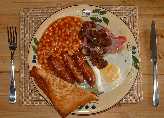
Click on the small image to be able to examine the larger image in more detail. Note the skilful way the flash highlights what is, to me, an acceptable level of fatty gloss.
England and indeed the United Kingdom has as many variants of the dish as there are regions within it. The dish you see here has most of the essentials bacon, sausage, eggs, baked-beans, mushrooms, but minus halved-fried tomatoes (and boiled plum tomatoes) and lacks the local delicacy called Black Pudding ( This is a northern speciality made from pig's blood and fat, which comes in a chunky sausage shaped 'chub' , is cut into thick slices and fried.) You might expect too, to see triangles of toast , marmalade and other jams to complete the picture, and of course, either a cup of tea or coffee. Most Brits have abandoned the gentile cup and saucer in preference for the more practical, larger mug ( which, incidentally, I have never seen on the breakfast table in any English hotel I have ever stayed in.)
FURTHER READING
RIP FULL ENGLISH BREAKFAST(Lament at the loss of this tradition)
ROUGH GUIDE TO MAKING THE FULL ENGLISH BREAKAST
( comes without a health warning)
PRAISE THE LARD (Rather more learned article than mine , about fat and related current food health issues and apparent myths.)
johncoxon 2:54 PM - [Link] - Comments ()
...
THE REAL ECONOMICS OF SMOKING
Monday, May 26, 2003
The British statistics of modern revenue from smoking are astonishing. Ah! Smoking, that addictive habit imported by Sir Walter Raleigh, in the reign of the first Queen Elizabeth, from the New World, the United States, and immortalised in that legendary, fabricated comic trans-Atlantic Elizabethan phone call courtesy of American comedian, Bob Newhart, explaining the use of tobacco to an incredulous Old World listener, who when told you ignite the tobacco asked Raleigh, " And then Walt, what do you do ? Do you stick it your ear? " ) We are told that, when Sir Walter Raleigh first put tobacco in his pipe, on return to England, his servant threw a bucket of water over him to save his master, whom he thought was actually on fire. Yet the smoking habit was not extinguished at birth and our government and a lot of business fat cats and their investors are very grateful to Sir Walter indeed.
Here are the stark statistics which make quite incredible reading. Smoking costs our struggling National Health Service, annually, some £1.5 billion pounds in health costs (from smoking related illnesses and their treatment.) Smokers keep a lot of medical staff in regular work and also make a significant contribution to the economy, both for the government and tobacco related businesses. Were the slowly diminishing number of smokers in Britain all to give up, tomorrow, for health and social reasons, the British economy would immediately collapse. 
Our amoral Treasury, with this deceptively re-assuring looking official royal crest, nets a staggering £7.6 billion 'coughed-up' by smokers annually. Smokers are, compared to the rest of the world, very heavily penalised, tax wise, in Britain, for sparking up ( lighting) addictive cigarettes or using other tobacco products . Penalising the smoker by raising the tax by, say a few pence annually, is something we weed addicts have learned to expect and accept from successive governments when each Chancellor of the Exchequer, whatever political flavour, knows that nicotine addicts will continue 'cough -up' , or 'pay through the nose', whatever price increase you force on them, red box in hand when announcing plans to make our economy buoyant in , well, any financial year.
A 20-a-day smoking person spends, on average, £1,600 a year and an awful lot of that money goes directly to our hypocritical, rip-off government in revenue.( You can't help but wonder, as a concerned Brit, how come, when, nationally, relative to other countries, we are taxed so heavily, why isn't the general standard of living here , so much higher, and why do so many vital public services rely on public generosity through donations to a multitude of registered charities ?) The Treasury earned £9,510 million in revenue from tobacco tax for the financial year 2000-2001: £7,648 million in excise duty and £1,860 million in VAT.
The price of a pack of 20 premium brand cigarettes currently costs around £4.40, of which a staggering £3.51 (80is tax.
It is estimated that about 25ý0of cigarettes consumed in the UK have been smuggled into the country. ( More on that later ) In order to try to combat the growing problem of tobacco smuggling, the Government has launched a programmed of measures costing an amazing £209 million. ( presumably funded by smoking revenue !) This includes increasing the number of Customs and Excise staff at key entry points such as ports; the use of scanners to detect cigarettes hidden in containers; the introduction of 'tax paid' stamps on packs; and a public awareness campaign to encourage the reporting of illegal activity. ( That last one sounds like a real winner! I think not .
The government, in my view, is in denial about smuggling, and will not accept that excessive taxation, higher than almost any where else on earth, for tobacco products, ensures that tobacco smuggling will remain a flourishing black market industry, whatever they try to do about it. Were the Treasury to relent and tow the line, for example, with the rest of Europe, ( which would mean a more than 50eduction in tax on cigarettes and tobacco products, ) tobacco smuggling would cease, immediately, to be worthwhile.
Despite all the new restrictive legislation, a phenomenally crazy, £135 million is still spent on tobacco advertising and promotion in the UK each year. (This includes an estimated £70m spent by the tobacco industry on the sponsorship of Formula One motor racing in the UK.)
The Government estimates that a tobacco advertising ban in the UK would lead to a drop in tobacco consumption of around a mere 3hich will save approximately 3000 lives in the long term. But given the huge revenue cigarettes bring in annually, they have an obscene dual standard and complete vested interest in not genuinely discouraging people from smoking, in my view. Smokers, gradually killing themselves, voluntarily, are vital to this Government's economy and it seems many previous ones.
Now I have to admit that, horror of horrors, I am an addicted smoker, and conversely, a vital element to the economic stability of my country. Health wise, I may be seen as a misguided person, who puffs for Britain, but in real economic terms it is an act of self-destructive extreme patriotism.
My particular favoured brand, Mayfair 'King' Size ( a joke because these cigarettes are relatively the cheapest and ridiculously short.) are made by the Gallaher , who originated in Ireland but are now a global company who kill off a lot of people annually in a variety of countries with their market leading brands like Benson and Hedges, Berkeley et al. I always thought that the crest on their Benson and Hedges packets and indeed Mayfair was a Mickey mouse logo trying to give a pretend sense of integrity, history and responsibility. It turns out that their crest is kosher and has been officially registered at the U.K's Royal College of Arms, (which regulates the design and use of Coats of Arms.)
Gallaher have their own expensively designed web site GALLAHER TOBACCO which like all alcohol global conglomerates, for example, has an earnest, but rather hollow rhetorical mission statement, policy statements on social responsibility and the rhetoric of concern for the health of the nation, even though that is not in their or their shareholders' interest. Underlying every web page, to my mind, is the usual , amoral business -based total indifference to the human social and health costs of their huge profit motivated affair.
Gallaher made am enormous half -term, pre-tax profit , last year of a staggering 23and that, in terms of real money, represents a total of £223m. Given the way that social habits have changed and that smokers are now a breed of social outcasts, immediate personal environmental polluters, and purveyors of passive smoking cancers, on the run and becoming social pariahs, that figure amazes.
Now this I find totally bizarre, the most recent packaging of the brand I smoke. Advertising on TV and hoardings for all tobacco products is now banned nationally, and we have had those adverts, while they were allowed, with caveats from H.M. government whispering the risk to health as a mandatory addendum. Look at these two images of a pack of the cigarettes I smoke, which has recently changed, dramatically , for what reason, I have no idea. To save space, the images are behind this little clickable blue image.

This is incredible, in my view. Now the Government warnings are bigger than the name of the product, and that is supposed to represent responsible concern for my health. I make my choice, as I always do and they net the profits, having done their statutory, hypocritical duty to provide these emboldened caveats that they need me to ignore for the economy to flourish.
You will note also, the new inclusion of the words , in bold, with the assertion "UK DUTY PAID". This message is very much tied H.M. Customs and Excise's rather pathetic ploy to counter our ever-flourishing tobacco smuggling trade. (That 'For Adult Use Only' message will relly discourage kids !Not.) The Customs epitomise the total government duality in terms of our membership of the European Union and their faintly bogus activities as one of the most powerful , above the law, professional government body, flies in the face of assumed common rights of the individual theoretically protected here under membership of the EU.
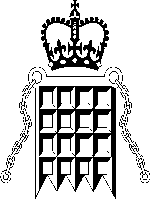
Their logo is this trusty portcullis with chains, that traditional emblem of protection; the iron grided middle ages castle gate we saw on the old "thru-pence" piece . Effectively, H.M. Customs and Excise are the Treasuries free-lance enforcers. (They do sterling work, mind you, tracking down and bringing to justice importers of harm-doing hard drug runners.) They also search you at ports of entry , occasionally now, can wreck your luggage but have no legal necessity to re-pack your things or compensate you for the damage they do. You can have all your orifices searched by a customs officer and you have no effective right to decline or for recompense if they find nothing contraband stashed in the various natural holes in your body.
Customs are nit -picky people, concerned in the main, even now, to find out travellers who have one extra bottle of liquor, for example or some other goods over the miserly quotas the government lays down, and who are illegally, according to them, avoiding taxation and thus potentially threaten our economy. These sort of invasive searches are very controversial now that we are members of the European Union. Technically, they can only search you now if they can prove grounds for suspicion that you may be attempting to smuggle, but effectively they still operate randomly, breaking their own rules. Effectively now, since when we buy in EU countries, alcohol and tobacco products, jewellery, watches, perfumes, etc, we pay lower tax to those countries governments as part of the purchase price, and technically, we should be free from additional penalties bringing those duty paid products into Britain.
Ironically we still have 'Duty Free' shops at airports and sea-ports, but that is now a joke and travellers shouldn't be misled, especially when travelling within the European Union. The best advice is never, now , to buy anything at a port or airport; buy in the regular shops in the country you visit and technically you can bring back , or take away, within the EU at least , as much as you like. But beware, as I still am, at the difference between the rhetoric and reality from our CUSTOMS web site. You have the legal and technical right, for example to import, for your own use, as much alcohol and tobacco, as you want.
But Customs have an unofficial Tariff and also a partisan view of what amounts to a stash that could be deemed for personal use. The onus is on you to prove that the goods you bring in are for personal use and not, as they want to discourage, for reselling on the streets and black market for profits that the Treasury would be jealous of and want to protect. They estimate that 1 in 5 cigarettes smoked in Briatin are smuggled and that between 2000 and 20001 the Treasury lost £2800 million in lost tax from tobacco smuggling. Since last year, Customs seem to relented because then, they actually strongly hinted to me that, even though technically you are free to bring as much as you like in, more than some 800 cigarettes then still eft you open to the suspicion of smuggling. Check out the latest rules here.. ALLOWANCES There seems to have been quite a major change of heart and this year they are quoting 3,200 cigarettes , for example, before you would be suspected of smuggling. I'd want that in writing before trying to come in with that allowance in my car.
I actually phoned ( there is a headquarters in my region) for clarification at the paradoxes in the rhetoric of the official website before my last trip to France. Why a limit when leaglly ther can't be one for personal use? They told me that they considered , for example, the shelf-life of tobacco products when assessing whether an amount constituted reasonably , 'for personal use' and also whether a person had attempted to conceal their imports. Oh yes. I'm going to bring my car back into Britain with all my wine and fags in open view so I can get myself mugged. Right! Not. I know that cigarettes are perfectly usable for quite a considerable period if the packets are not opened, and, as I have said previously, there is no way I would sell on fags (cigarettes) I had bought more cheaply on the continent, because I would save a lot of cash smoking them myself. At least now, the criteria for not arousing the supsicion of smuggling are actually written down and that is a step forward, since last year at least, the web site advice then was far from honest.
I made an estimate of how many cigarettes I'd consume in, say four months. The official (before they steal your stash and your vehicle for H.M. Treasuries benefit, which you can currently do very little about ) view is that 3,200 cigarettes is their idea now of what constitutes 'personal use'. I smoke roughly 800 cigarettes a month and thus, would seek, before my next channel crossing to import at least that new allowance number of cigarettes. For me that would be reasonable personal use, but why can't I bring in supplies for much longer as I have a legal right, under European law to do? If I risked challenging these partisan rules and brought in more than that new allowance, I'd have to take them to court to assert my actual rights as a citizen of the European Union, and that would probably cost more than the value of my car they'd have confiscated and my stash and don't they know that.
Now on the other side of things there is a huge black-market in smuggling alcohol and cigarettes into the country, and I know that, regularly, organised individuals, usually in large white vans ply to a from the continent with their vans loaded up to the gunnels with contraband. They are doing it as their main source of income, and the occasional risk of having their vehicle confiscated as well as their contraband is part of the acceptable economics of a flourishing trade. My local newsagent, Les, incidentally, admitted to me, that, he hardly sells any pouched tobacco for those who roll their own cigarettes these days. Pouched rolling tobacco is so expensive here because of tax and most people get their supplies from the black market. Les does , however, do a roaring trade in cigarette papers, for use, I guess, for those tax avoiding smokers, and of course those who need six papers at time for making cannabis spliffs.
Finally, the event today, that triggered off this very long, heart felt entry, a visit to the local 'Safeway' supermarket . At the counter, where I bought my cigarettes I saw a lovely little bit of fruitless government advertising, from those delightful Her Majesty's Customs and Excise people. You have to see this. I had to laugh and I am sure you will appreciate the irony, having read this long essay ! So impressed was I, with this staggering waste of tax payer's money that I asked special permission to take a photograph of it. Click the pirate image to see my original photo of the Custom's advertisement 
Effectively, it is a warning not to buy cigarettes from car boot sales, street corners or markets, because, horror of horrors, they may be smuggled or counterfeit and the sign gives a phone number where you can inform on the person 'flogging' cheap cigarettes. Yeah. Right. I pay nearly £4.00 sterling ( or more) for a packet of cigarettes, and 80f that is tax that goes straight to the government. And, Oh yes, someone offers me 200 hundred cigarettes for £20 , I'm going to say , "Oh no, that's harmful to the government and our economy" and immediately grass the guy up via that hotline? I don?t think so. The government, you have already read, makes huge revenue from wildly over-taxing smokers, as indeed, Gallaher make huge profits from their nasty business. Irony of ironies, is that, if you look closely at the smaller print on that little risible Custom's advert card, bottom right, you'll see Gallaher, the Imperial Tobacco Company and Rothman's , the three major players in the evil UK weed trade, support and endorse this government's unproductive campaign. No need to wonder why. You have to ask where the real villains dwell; Whitehall and the Tobacco company offices in my view.
Cigarettes are so much cheaper in all other EU countries, about half the price they are here. Not withstanding the health risks that all smokers know about and accept , that is their choice, however foolish it may seem. However big the bogus health warnings on packets get, they will continue to be ignored by people like me and companies like Gallaher rely on that. They tell us what we already know but they are not concerned about our health but simply the continued prosperity of their industry. Big, unavoidable health warnings are simply to put the onus on us ; they are legal disclaimers, solely designed to release tobacco companies from culpability and, more importantly, free them from the ever present recent danger of hugely expensive litigation.
Cigarettes are not subject to such excessive taxation in neighbouring EU countries and the Customs, hit-people for the Treasury, are never going to win the battle against smugglers until they start to act legally, and endorse the laws of the European Community to which we now belong. Because of vested interest, the government will never halve duty on cigarettes, or one day give into the individual's right,( as a member of the European Community, having paid valid taxes in that country, ) to bring in here, the things they have legitimately bought without further, illegal penalty. That would be so inconvenient to an insular economy that is maintained by ultra high taxation on so many products that can be bought so much more cheaply in members states, and , ironically, even products that originally, were made in Britain.
Britain, Napoleon once unkindly remarked, is a nation of shopkeepers, when in fact, he got it slightly wrong. We are a nation of uncomplaining consumers , constantly being ripped off , from every direction, tax wise, by our own government.
johncoxon 4:20 AM - [Link] - Comments ()
...
DIGITAL CAMERA FAULTS /FLASH GLARE
FLASH FAILURE
I went through a frustrating patch of taking photos with my Fuji digital that came out either dark brownie orange or just dark when shooting in conditions that needed flash. I always suspected the batteries and indeed when the power in them is low the flash tends to under light subjects. I discovered later that the phenomenon was caused not by some technical fault directly but by my finger! It just happens that the way the camera body is moulded, it is really comfortable to wrap your finger in the rebate exactly where the inbuilt flash has its aperture!
UNWANTED GLARE
I have been irritated more than once with my Fuji 2800 zoom digital camera. It has a range of flash settings except the one I want. No flash.
MY NEW INVENTION
Necessity being the mother of invention, I stumbled over a solution to the problem of unwanted inbuilt flash. Click on the word FUJI FUDGER to see my patented design. I had tried going outside in good light and having the flash on Auto, but it still fired off and cause unwanted flare. I had tried using subdued flash and also taking glossy reflective surfaces from a range of angles to get a shot without a patch of glare. This afternoon, it dawned on me how best to disable the flash! Nothing very high tech, I simply thought of using my finger over the inbuilt flash window and it did the trick. Yippee. (You won't find that one in the handbook.)
UNWANTED WHITE SPOT
I noticed too that some of my photographs were spoiled by a whitish blob that appeared on some images now and again, fading a circular patch of a photgraph and I presumed that I just needed to wipe the lens. Now I think there is a tiny bit of moisture inside the camera that is causing the problem. I have now put my camera in 'jiffy' bag ( padded mail bag) with some of those little silica gel bags I conveniently found in the packaging of a few electrical items I have around the house. Fingers crossed it works.
johncoxon 8:18 PM - [Link] - Comments ()
...
GREETINGS FROM BASRA
Sunday, May 25, 2003
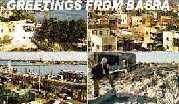
(Click on thumbnail for a larger image.) Peace, unlike war, has a habit of not making the news. It is easy to forget that large numbers of
solidiers from the United States and Britain are still doing sterling work in Iraq. All their families must be so looking forward to having them home again. Letters to and fro from the theatre of operations (and the occassional satellite telephone call for Brits), are so important to troops and their families alike. In Britain, regiments suppliment their soldier's personal communication with more general E mailed newsletters. We get fairly regular E mailed 'updates' from the Battlegroup still working hard with humanitarian work in BASRA as Word documents attachments courtesy of the Royal Fusiliers Regiment which Steve Hanson, Naomi's father, is attached to. All the updates bare testament, from the various officers writing, that letters from home are vital for keeping the men cheerful, in what are, for all of them, are pretty bog-standard ( basic)living conditions. Steve told us recently in an e bluey ( forces airmail) that he had built a make-shift shower for the boys, fed from a roof-top water tank he'd rigged up. trouble was, in that climate, the Heath Robinson,solar heated water was too dam hot! Click of the bold link here to read the latest news. It brings home the personal side of a military operation and is part of the Regiment's effort to re-assure military families back home who are naturally missing their loved ones and anxious to hear any news.LIFE IN BASRA
The British Minsitry of Defence maintain web pages relating to what we in Britain call OPERATION TELIC ( know as Operation Iraqi Freedom in the US) and this includes a regularly updated gallery of high resolution photographs directly from Iraq. Current photographs include troops re-consecrating a WW1 Brtish military cemetery at Al Kut. At Al Kut, US troops discovered a badly overgrown British war cemetery, the last resting place of several hundred British and Empire troops who fell during the Mesopotamian campaign in the First World War.( Al Kut was the scene of much heavy fighting, including both a disastrous British defeat in 1916, and an important victory in February 1917.) Also included are soldiers helping to repair railway lines so that humanitarian aid can be distributed more effectively, a military policewoman mobed by kids following the re-opening of a school, and a soldier giving mine-awareness classroom lessons to locals. It also includes a couple of classic images of young British soldiers on patrol on bikes, rented from locals to help the economy, and preferred because that mode of transport ensures greater personal contact with local people and offers access to areas unsutiable for vehicles.lick on this word link to go directly to the MOD TELIC PHOTO GALLERY Click on this bike image to see a collage I've made made up from the image gallery.
Steve is attached to the Royal Regiment of Fusiliers. Their distinctive regimental cap badge features red and white plumes, making them instantly recognisable.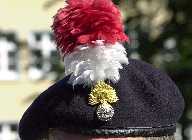
Click on the next bold word link to visit the Fusiliers'regimental website, which includes a regimental history, explanation of their colours ( battle honours), a gallery of contemporary photographs, and a 'What's New' section which features more updates on the regiment's work in Iraq.FUSILIERS
Finally, in a recent bluey to Naomi, it was clear that, for him and his comrades, living and working in Basra had been a salutary experience, not only the deaths and casualties of the actual fighting, but the pretty primitive living conditions that mosy ordinary Iraqi civilains see as their norm ( even before the War it was that basic) Clearly, Steve will have learned to appreciate just how lucky we are and how we take so many things for granted at home. "Live every day as if it was your last" seemed a somewhat stern caveat from a dad to his young daughter, but this gentleman / gentle man is only passing on in a loving way, what life has taught him to his daughter with best intent.
Kipling once remarked that soldiers were beloved in war time and despised in peace time, but, a lot of our young service people will return home and live hhenceforth live their own lives in a different way, based on their experiences. Some will, tragically, have be irrevocably psycholigically damaged by the trauma of warfare and will need our support. Others will add something for the better, to the lives of those around them when they come home. You don't really know what you have until you've faced the prospect of having it taken away from you.
johncoxon 11:37 AM - [Link] - Comments ()
...
MANCHESTER'S FIRST AIRPORT
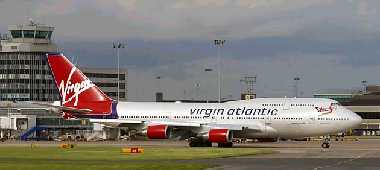
This great photograph is one of literally thousands of high definition images on the amazing aviation website CREWSTART and was taken at MANCHESTER'S INTERNATIONAL AIRPORT, the second largest in Britain, (next to LONDON-HEATHROW, in terms of size and passenger traffic.) But this isn't the original Manchester Airport. That is still in operation and this is what it used to look like in the early thirties and illustrates graphically, just how pioneeringly, frighteningly basic early air travel was. BARTON AIRPORT 1930's This photograph comes from a fascinating, easy to navigate (by a clickable map) local history web site, maintained by John Valentine, focusing on very old black and white photographs of the Eccles area, one of Salford's districts, and is well worth a visit for its pictorial insights into bygone Salford starting from just before the turn of the 19th Century.ECCLES PHOTOMAPS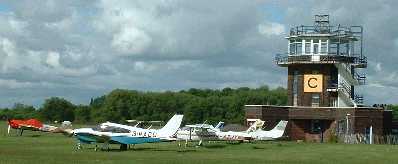
Here is a photograph (curse those rechargable batteries that run out at the least convenient moment) I took of Barton Airport this afternoon showing its original (and still operating) control tower along with just a few of the privately owned aircraft based there. Barton is the home of the oldest flying club in Britain THE LANCASHIRE AEREO CLUB The club began in 1922 as the result of a man called John F. Leeming building a glider in the garage next to his home with friends. Subsequently they formed The Lancashire Aero Club. The club has been based at Barton since 1930.
BARTON AEROMDROME as it is more properly known, was established as Manchester's first passenger carrying municipal airport in 1930. It has now, the earliest civil aviation hangar in England, with its associated workshops. The original passenger terminal, which includes a booking office and waiting room, was created at the same time by adapting farm buildings next to the airport entrance. Because, for its time, Barton was so innovative, those two buildings along with the original designated runways form a unique example of authentic 1930's aviation history. They have now, along with the original control tower, (built in 1932) been officially designated as Grade 2 listed buildings. Barton is thus a protected heritage site. Sadly, the adjacent lovely Barton Airport Hotel was, curiously, demolished just a few years back, but the nearby Airport Garage is still there, serving passing motorists. As well as the thriving Aero club and Helicopter service, the Manchester Police 'Spy in the Sky' helicopter 'scrambles' from Barton. ( Scramble was a war time expression for when RAF pilots were ordered to get in to the air as quickly as possible, or 'scramble')
Every time I visit Barton Aerodrome, I get an incredible feeling of stepping back in time and a real sense of how 'paper and string' was the technology in the early days of aviation. There is no radar here ; the control tower uses direct radio contact, aldis lamps for pilots who don't have radio, and basic visual contact from the tower to guide planes in. They have the traditional orange wind sock outside to show wind direction, and two simple dials indoors, one a wind speed indicator and the other a wind direction indicator! The design of the control tower, thought to be the oldest working one in the world, is so reminiscent, for me of those from Second World War British airfields that countless RAF fighters and bombers, their crews in sheepskin jackets and leather flying helmets, took off from. I often expect to see an RAF 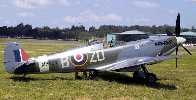
my all time favourite flying machine, land here and it wouldn't look out of place. Click BIG SPIT for a larger image. (I used to make AIRFIX plastic scale model aircraft as a boy. The four propeller, Rolls-Royce engined, AVRO-LANCASTER BOMBER (clickable photo word link) was another favourite and, incredibly, built within a stone's throw of Barton Aerodrome, at Trafford Park. It had similarities to the smaller twin prop American Mitchell bomber. Naturally, RAF airfields during the war, were not built near towns or cities becuse of the risk to civillians from enemy night bombing targeting and thus, war planes would not have taken off from Barton during the war I would imagine.
My ex-father-in-law, Daniel Wynford Richards, ('Wyn') a modest , and to my mind very English, Welshman and natural gentleman, from a small village just outside Swansea, called Pontadulais, flew on Lancaster bombers, as a very young man, over Germany in the Second World War. He lost many of his RAF colleagues and friends. (A visit to Flambards in Devon, awhile back. where, in their air museum section, they have a genuine, but no longer airworthy Lancaster bomber, it was poignant to get a really close look inside this plane in view of the family connections) These huge, relatively slow moving but sturdy and reliable aircraft, were very vulnerable to the faster enemy fighters, and thus many crewmen and planes were lost. The rear-end gunners were particularly vulnerable and were known as 'Tail-End Charlies', a term that some of our surviving bomber crew and gunners think of as an unwelcome Americanism. Of 55,888 aircrew killed in Bomber Command in WWII, over half, a staggering 28,350 were Air Gunners. Of all the total sorties flown, only about half came back.
I had the privilege to see Wyn's, flight log book shortly after his untimely death. In his lifetime, he was reluctant to talk about his war time experiences in Lancaster bombers (he was invalided out because of stomach ulcers brought on, I can very easily imagine. by the sheer stress and terror of that work on such a very young man. Indeed, the Chapel where I married, was where he had attended the funerals of some of his close RAF friends during the war, and that ceremony made him tearful with the hard knock remembrances of that venue. As I read his log, the hair on the back of my neck stood up as I read his brief, dismissive, bravely cavalier comments about having , for example, come under attack from enemy flack and cannon fire. There were also brief but rich compliments written by often much older crew members, appreciative of the younbg man's precocious courage and professionalism. My grandfather, incidentally was a member of the RFC (Royal Flying Corps) in the First World War, before it changed its name to the RAF, but that's another story.
Because of great national pride in the outstanding performance of the RAF in the Second World War, our airforce maintain what is known as the BATTLE OF BRITAIN MEMORIAL FLIGHT based now at Lincoln. 11 original wartime aircraft of 6 different types have been lovingly restored and are carefully maintained and regulalry flown for events and special national occasion 'fly pasts.' The current flight includes 5 Spitfires, 2 Hurricanes, Lancaster, Dakota and the last 2 operational 'Chipmunks' (pilot training light aircraft)in the RAF.
The motto on the Flight's badge is 'Lest We Forget' and , to my mind, this initiative of restoring and keeping flying these icons of British steadfastness is a wonderful tribute and mark of great respect to the dedication and courage of those, like Wyn Richards, who had to actually fight in them.
johncoxon 10:45 PM - [Link] - Comments ()
...
RECLAIMED TIMBER PLANT BOXES

Here
is the galvanised steel fire bucket bracket I salvaged from that near by pig farm and put to good use in my garden.
From that old farm I got a lot of old timber.and cut it up to make planters and window boxes in a simple box construction. Here in England you can buy plastic 'troughs' to plant flowers, but I really dislike plastic and try to opt for ceramics, or wood to give a more natural look to our the garden. I have concealed the plastic troughs in simple window box structures that are so easy to make.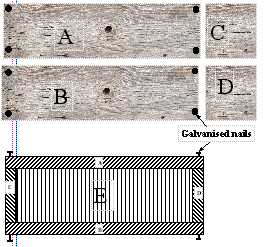
Measure your trough and allow for the box you want to conceal. Nail the sawn pieces together as I illustrate in this diagram, and having nailed together the frame, pieces ABCE, stand the structure over another piece of timber, mark out, cut out and nail that to make the bottom of your simple box. Here is an old wooden box I found complete in the long grass at the farm, and I simply planted herbs in it, along with a planter I made from bigger old timbers I rescued. 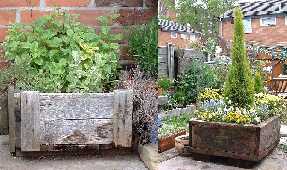
I made a number of simple 'window boxes ' for our back yard from all that reclaimed timber too using that simple method of box consreuction .
johncoxon 2:24 AM - [Link] - Comments ()
...